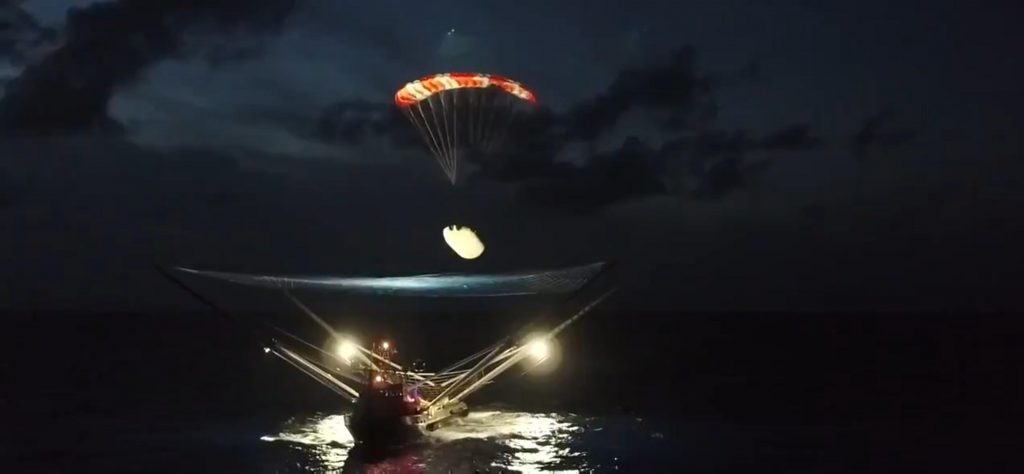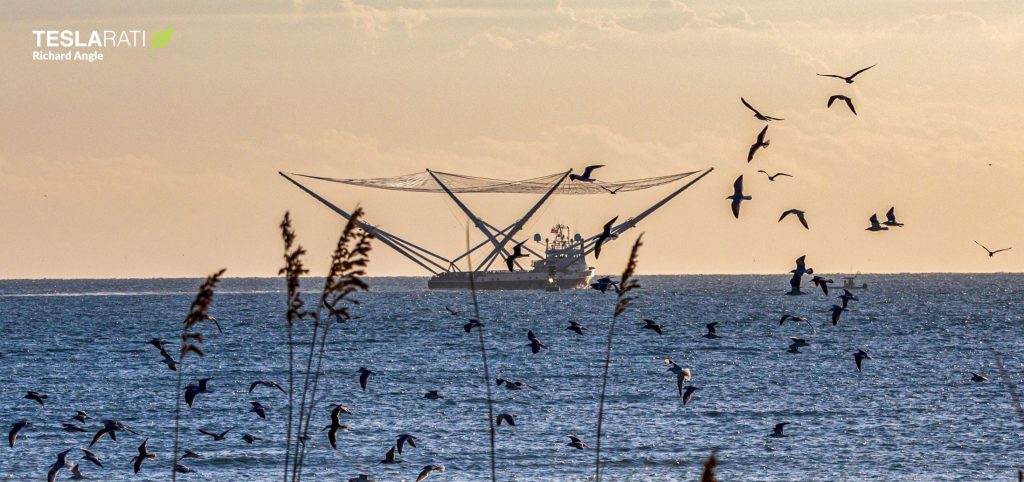After a brisk day-long cruise into the Atlantic Ocean, SpaceX’s twin Falcon fairing recovery ships have reached the general landing area to prepare for their first true ‘whole-fairing’ catch attempt.
Formerly known as Mr. Steven, GO Ms. Tree and new sister ship GO Ms. Chief departed Port Canaveral on December 14th and arrived at their designated recovery roughly 36 hours later. Now stationed just shy of 800 km (500 mi) downrange of SpaceX’s LC-40 Cape Canaveral Air Force Station (CCAFS) launch site, the ships are in position and can begin to prepare for Falcon 9’s Kacific-1/JCSAT-18 launch.
Scheduled to lift off no earlier than (NET) 7:10 pm ET, December 16th (00:10 UTC, Dec 17), Falcon 9 will place the ~6800 kg (15,000 lb) Kacific-1/JCSAT-18 communications satellite in a geostationary transfer orbit (GTO). Falcon 9 booster B1056 will attempt its third landing around nine minutes after launch, to be followed 25 minutes later by satellite deployment from the rocket’s upper stage. deploying the satellite around thirty minutes after launch.
If all goes according to plan, another 12-15 minutes after Falcon 9’s second stage (S2) deploys the Kacific-1/JCSAT-18 satellite, the rocket’s payload fairing halves will begin their final approach towards recovery ships Ms. Tree and Ms. Chief. Just shy of identical twins, the two ships have been outfitted with custom arms, boom supports, and nets with the intention of quite literally catching payload fairing halves out of the air after orbital Falcon 9 (and Heavy) launches.
SpaceX’s fairing recovery development program has had a long and arduous journey from Mr. Steven’s (now Ms. Tree’s) arrival at the company’s Port of Los Angeles dock space (late-2017) to the ship’s first attempted fairing catch (February 2018) and first successful catch (June 2019). In the 20+ months SpaceX has been attempting fairing recoveries, at least a dozen intentional soft ocean landings and seven net catches have been attempted, with numerous successful splashdowns and recoveries ultimately followed by two consecutive catches in June and August 2019.


The fact that SpaceX consecutively caught two fairing halves a little over two months apart after five failed catch attempts suggests that the company has effectively solved the majority of the fairing recovery challenge, becoming the first company (or space agency) in the world to do so. Unfortunately, a three-month launch lull after the second successful catch precluded any rapid-fire follow-up attempts and when that lull came to an end on November 11th, Ms. Tree and Ms. Chief were both ready but were forced to abort the attempt by rough seas.
Both ships actually spent several weeks docked (or stranded) in a North Carolina port after that aborted mission, potentially indicating that SpaceX had to fly a team north to inspect both ships’ arms and ensure that they could make the journey back to Port Canaveral. They were ultimately cleared and returned to their home port around ten days later, where their arms and booms were immediately removed. It’s unclear why that removal occurred but SpaceX’s recovery team rapidly reinstalled their arms in just a few days, followed by their nets soon after.
Given that their first simultaneous (i.e. ‘whole-fairing’) catch attempt was aborted before it could start, it’s safe to say that December 16th’s hopeful attempt will be Ms. Tree’s and Ms. Chief’s first side-by-side recovery mission. Both ships have successfully reached the recovery zone, a step further than they managed to get on their November attempt. Coincidentally, that November launch happened to mark both SpaceX’s and the world’s first launch of a flight-proven payload fairing, both halves of which were recovered from the ocean and represented a more or less worst-case scenario for reuse.
And nevertheless, that reuse was a flawless success, marred only by the fact that Ms. Tree and Ms. Chief were unable to attempt to recover the world’s first twice-flown payload fairing. In short, all the conditions are right for what could be the world’s first successful recovery of both halves of an orbital-class payload fairing. If successful, SpaceX will have effectively closed the book on Falcon 9 and Heavy reusability development, having proven that both boosters and fairings can be reliably and routinely recovered and reused.
Check out Teslarati’s newsletters for prompt updates, on-the-ground perspectives, and unique glimpses of SpaceX’s rocket launch and recovery processes.

(adsbygoogle = window.adsbygoogle || []).push({});
<!–
–>
var disqus_shortname = «teslarati»;
var disqus_title = «SpaceX recovery ships head to sea for first 'whole-fairing' catch attempt»;
var disqus_url = «https://www.teslarati.com/spacex-fairing-recovery-ships-second-catch-attempt/»;
var disqus_identifier = «teslarati-123485»;

